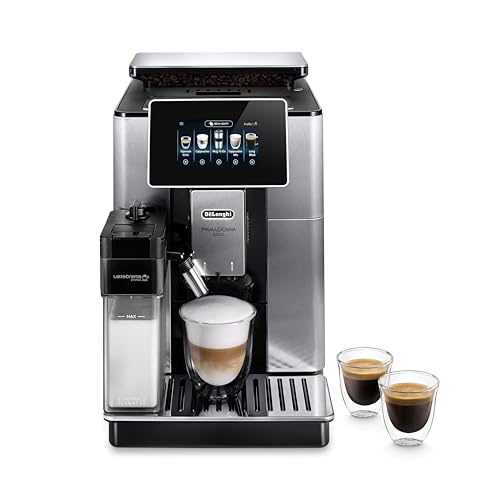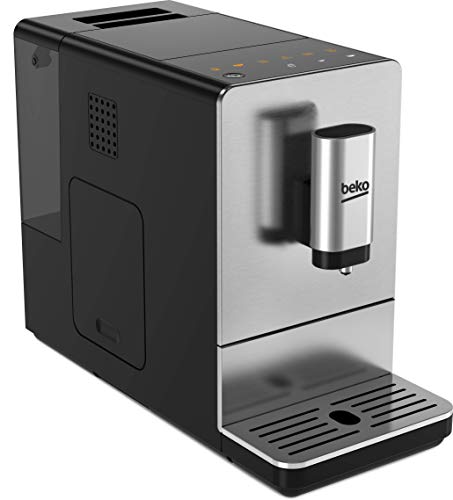It's The Bean Coffee Machine Case Study You'll Never Forget
페이지 정보

본문
 Coffee Bean Coffee Machines
Coffee Bean Coffee MachinesWhen you purchase the coffee bean to cup automatic coffee machine machine you can enjoy delicious, fresh whole-bean, roasted coffee that is prepared according to your specifications. The machine grinds, measures, tamps and pushes hot water into the grounds to create delicious, flavorful coffee.
 These machines have many advantages such as ease of use and a reduction in environmental waste when compared to pod machines. The machine is fully automated and operates at the touch of one button.
These machines have many advantages such as ease of use and a reduction in environmental waste when compared to pod machines. The machine is fully automated and operates at the touch of one button.The following are alternatives to the word "grind"
The type of grind you use is essential to making a good cup of coffee. The particle size shape, shape, and consistency are all vital. Incorrectly grinding beans can cause the water to flow too fast through the grounds and result in under extraction of flavor or excessive extraction of bitterness.
A good grinder will have various grind sizes to give you options for different brew methods. It is essential to test different sizes of grinding, as they can drastically alter the flavor of your brew. The smallest sizes of grind are perfect for espresso and French press, while the larger, coarser particles will be best bean to cup coffee machine for brewing in an immersion vessel like the Chemex or Moka pots.
If you're looking for an even more delicious cup of coffee, consider roasting your own beans and grinding them prior to making the coffee. This will increase the aroma and flavor of your brew, and ensure an excellent cup every time. To ensure the freshness and flavor of the beans, store them in a sealed airtight container in a cool, dark area.
Commercial machines that make coffee provide unparalleled convenience. They let you enjoy barista quality coffee bean coffee Machine (directorydepo.Com) at the touch of the button. These machines take care of everything from making the beans, to tamping them, making them an ideal option for busy cafes and offices.
They start by grinding your choice of beans to a precise grind size. They can be adjusted to suit the specific brewing method you prefer, and can be programmed to dispense the appropriate amount of cups or shots simultaneously. Some machines will automatically compact the grounds to ensure the best extraction.
A bean-to-cup machine typically comes with a large hopper can be filled with whole beans. The machine will automatically grind and dispensing the right amount of the brew you choose. The display on these machines will show the amount of beans and the size of grind you have selected. It will also display the total number drinks that the machine is set to prepare.
Extraction
When the coffee bean is ground it breaks up into smaller pieces, referred to as particles. The size of these particles could affect the way that coffee is extracted and therefore how good the final cup will taste. In a bean-to-cup machine, the size of the beans is controlled prior making coffee so that it lines with the type of extraction needed by the machine. This lets you make a great cup of espresso each time, without the need for barista skills.
The brew time in the bean-to-cup machine can be controlled to achieve precisely the strength you desire to drink. This is a major advantage over pod machines that offer you less control, and can lead to less bitter or weak espresso. Bean-to-cup machines allow you to regulate not just the brew-time but also the water temperature. This allows you to determine how strong the coffee will be.
Extraction is a delicate process that is based on a balance between the size of the particle and dose as well as the force that is used to tamp it. A poorly extracted coffee can be the result of any of these variables. Coffee that is not extracted properly will taste sharp and sour While coffee that has been over-extracted will taste bitter and dry.
To ensure that the coffee is extracted correctly, you need to make use of a high-end grinder and the correct type of beans. Light roasts are often a bad choice when using espresso or fully automatic machines due to the short time for extraction can leave the coffee lacking body and flavor. Darker roasts with a higher Robusta percentage, like our Jhai (100% Robusta) or Tiga Terra are a better choice for these machines because they offer more robust flavors and bodies.
In the end, deciding between a bean-to-cup machine and a pod coffee machine comes down to your personal preference and the convenience. Pod coffee machines can provide an easy method to make coffee machines bean to cup and tea, but they tend to be less cost-effective than a bean to cup machine and can produce significant waste due to the disposal of used pods.
Dispensing
Whole beans eliminate pods, saving you money and providing more flexibility. However this also means that your machine requires more regular maintenance and cleaning than a pod-based model.
Fortunately they've been designed with low maintenance in mind. Many have features that help with this. For instance, many bean-to-cup coffee makers have automatic rinsing and cleaning cycles, making it easy to keep your machine clean and not disrupt your daily routine.
Another convenient feature is the possibility to add hot, steaming milk to coffee beverages. This helps your team members make their drinks more suited to their preferences and tastes while increasing productivity. It is also a great way to show that you care for the well-being of your team. It has been scientifically proven that coffee may increase the production of dopamine as well as norepinephrine. This improves focus and motivation at work.
Some models also offer beverage customization options, including the ability to texturize milk for cappuccinos as well as lattes. This feature is a key selling point for baristas who might only have a limited amount of time to prepare each coffee cup.
The size of the water tank as well as the bean hopper size are important aspects to consider when you are choosing a top bean-to- cup coffee maker. The water tank determines the amount of time that the machine can run before it has to be replenished, and the size of the hopper determines the frequency with which you will need to replenish the beans. The larger capacity the lower the frequency at which you will need to replenish.
Before buying a bean-to cup coffee maker, carefully consider the type of beans you'll use as different grind sizes affect the taste and consistency of each cup. Additionally, you'll want to look into the machine's settings that can be programmed that let users alter their drinks to make their perfect beverage every time.
The dispensing spouts on your coffee bean machine may be blocked by coffee residue or other particles left behind after grinding. To avoid an inconsistent and slow flow that could result in an insufficient amount of grounds of coffee, the spouts should be cleaned regularly. This can be due to a coarser grind setting, too oily or dried beans, or a lack of regular cleaning.
Cleaning
Cleaning coffee machines is an essential aspect of maintaining them. It prevents the buildup and accumulation of residues, which can negatively impact the taste and quality. Regular cleaning ensures that the machine is in good condition and decreases the possibility of a breakdown that could lead to costly repairs. A lot of bean-to-cup coffee machines have an integrated daily cleaning cycle that flushes through pipes to cleanse the brewing unit. Others will include separate milk side cleaning cycle in order to ensure that both spouts are clean and safe.
A reputable rental company will normally train staff on the full maintenance and cleaning procedure during the installation. This helps to reduce confusion and ensure that steps are properly followed. Having clear instructions and a complete understanding of the process can help to prevent any mistakes that could result in costly repairs or low-quality drinks.
It is best to wash the carafe, the permanent filter, and brew basket after each use in hot soapy water, or in the dishwasher if they are designated as safe for this. It is recommended to run two or three cycles of clean water without any K cups or espresso ground in the machine. This helps to remove any oily residue and stop the build up of bacteria, yeast or mould.
It is a good idea for single-serve coffee machines and pod coffee makers to do a deep cleaning and descale every four weeks. A vinegar solution is usually used for this. Add up to 4 cups of vinegar in the reservoir, and then run the machine through an brewing cycle. Once the cycle is complete, rinse and descale as per the manufacturer's instructions and run a couple of cycles of clean water to eliminate any vinegar smell.
Commercial machines have a built-in Telemetry system that records every cleaning cycle. You or your provider can view this to ensure that the machine is being cleaned regularly. This could also notify you the possibility that any of the moving parts are stuck or have seized, which will require more precise maintenance and repair work.
- 이전글See What Repair Upvc Windows Tricks The Celebs Are Making Use Of 24.09.24
- 다음글Five Glass Repair Maidstone Projects To Use For Any Budget 24.09.24
댓글목록
등록된 댓글이 없습니다.

